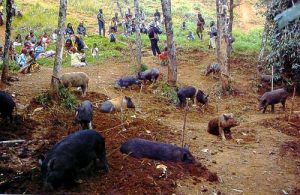As you may recall from my previous blog about pigs, the relationship between humans and pigs has been all over the place, from despised as filthy animals to being eaten by the millions. Actually, pigs and humans have so much in common that live tissue can be transplanted from one to the other, pig insulin is a boon to humans, and pigs are often the surrogate of choice when testing potential new drugs. According to some South Sea cultures, pigs were created so humans wouldn’t have to eat each other!
Experts guess that pigs were introduced to Papua New Guinea (PNG) from elsewhere, maybe as long ago as 10,000 years. Whether they have thrived or not is a matter of definition. PNG pigs are distinctive, and scrawnier than pigs with which we are more familiar. Wild pigs in PNG are slaughtered for food, but domestic pigs are eaten only when no other protein is available. Mostly they are kept for social and political uses, and are particularly important among tribes in the Central Highlands.
My interest in PNG pigs was triggered by my reading about pigs in general. I came across the fact that in Papua New Guinea, women sometimes nurse piglets. I had to know more! It turns out that in Papua New Guinea pigs have enormous economical, political, and mystical importance. They are used to buy brides, and to pay debts (for example, compensation for killing members of another tribe). Pigs are killed for important ceremonies, such as cremation, marriage, initiation rites, and to appease ancestral spirits. Pig killings are often followed by days of celebration. An exception is pigs that are sick or stolen, which are eaten as quickly as possible.
A man’s wealth is judged by the number of pigs in his household, and every few years, huge pig-giving festival are held to impress other tribesmen. The importance of pigs can scarcely be overstated. They are the only domesticated animal. And the care and feeding of the pigs falls to the women—along with virtually all the other work of the family, such as gardening, cooking, hauling water, gathering firewood, caring for children—and pigs! The men hunt or fish occasionally and protect against enemy attacks.
Someone named Adam, who reports working in PNG, posted the following online: “. . . And I have seen the women breastfeeding pigs. And there is a simple reason for it. Pigs are worth more to the tribe than children. You cannot eat or sell or trade children. . . A child eats your food, which in ten, leaves less on your plate.” Pigs must be kept alive until needed at all costs.
The women have very close relationships with pigs. The pigs accompany the women everywhere. Sometimes they spend the night in specially built sties, but others sleep in the same huts as the women and their children. They eat with the family. They are often given names and are treated as pets are here, being stroked, fondled, and cajoled in tender voices. Although women are the caretakers, the pigs are the property of the men. I can’t help wondering about what happens when a man decides to kill a woman’s favorite pig.
Although some people recoil in disgust at the thought of women nursing piglets, others cite more familiar examples of cross-species care throughout the animal world—for example dogs nursing kittens—and point out that people are animals, too.
The idea of a woman nursing a piglet is strange to us, at the least. But This has been the culture in Papua New Guinea for centuries. Who are we to judge?






